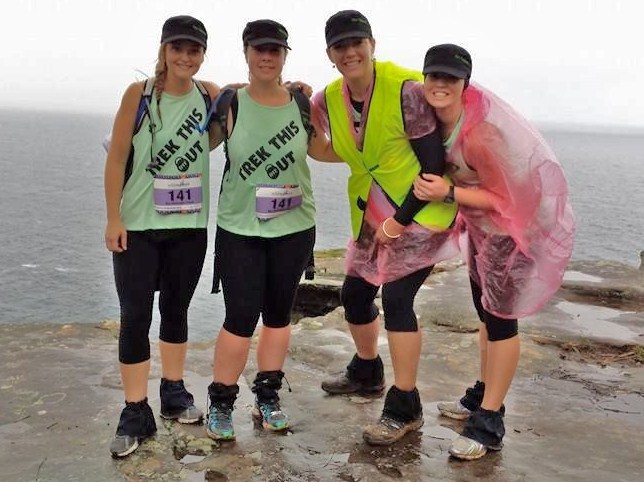April 2014 Newsletter
This time around we look at how you can take best advantage of your business structures to grow your wealth, we highlight changes to the superannuation contribution caps coming in the next financial year, and also congratulate Emma on her big walk for Coastrek in NSW.
In this edition...
 If you're in business, chances are you're set up in a way that's intended to minimise the tax you pay and protect your personal assets. Whether you utilise a trust or a company, have a self-managed superannuation fund or have more complex arrangements that involve combinations of entities, this is what is known as your business structure. It's there to help you, so it's important that you continue to use it to your advantage.
If you're in business, chances are you're set up in a way that's intended to minimise the tax you pay and protect your personal assets. Whether you utilise a trust or a company, have a self-managed superannuation fund or have more complex arrangements that involve combinations of entities, this is what is known as your business structure. It's there to help you, so it's important that you continue to use it to your advantage.
What do we mean by that? We find that many people in business assume that setting up their structure is an historical event that happens once and then continues to work for them. And to the extent that their circumstances (and tax laws) don't change, that is mostly true when it comes to the direct income and expenses of the business.
It's reasonably common though for people to undertake new forms of investment and expenditure without considering how to best use the structures they already have in place. Let's consider a couple of examples.
Where do you invest your money?
Say you're somewhere just either side of 50 years of age and operate a business. You have some investments that you hold in your own name and you also have a self-managed superannuation fund (if you don't, this is also a great example of why it's worth having one).
If you hold investments outside of superannuation, at some point you will have to pay marginal rates of tax to get hold of the income. You may distribute to family members to spread that burden, using other structures, but there's no escaping the fact that at some point you'll end up paying tax at personal rates. And you may even pay corporate tax of 30% along the way.
What's more, any assets that you hold in your own name may be at risk if your business runs into financial trouble or someone decides to sue you. A company or a trust may provide some protection from this, but the rules that provide such protection in Australia are quite strict and there is no 100% guarantee that your personal investments can't be touched (say, in the event of continuing to trade while technically insolvent).
Contrast this with superannuation. In superannuation, the most tax you will ever pay on investment earnings is 15%. On capital gains you will only pay 10% if you hold the assets for longer than twelve months. And once you turn 60 and start drawing a pension, you'll pay no tax at all on any income from super, even if you continue working.
Furthermore, because superannuation is intended to provide for you in retirement, it is almost untouchable when it comes to bankruptcy or litigation proceedings. There is no other structure that provides the level of asset protection that superannuation does. So why invest outside of super?
Perhaps it makes sense when you're younger. After all, most people can't draw on their super until they turn 60 (or 55 at the earliest) so once money is in there, you can't get it out again for a long time. In this case, it may be better to use a combination of superannuation and investments outside of super. But as you head towards your 50s and beyond, investing in super becomes more of a medium term savings strategy - one that is far more tax effective (which greatly increases your growth) and better protects your wealth.
If you have investments outside of super, you can move most of them into your self-managed superannuation fund. But there are limits on how much you can move each year. Once you reach age 65, those limits become even tighter and if you stop working after 65, they become non-existent. So it needs to be a strategy that you begin to implement before you transition to retirement, not only to make sure you can move as much as possible across, but also because growth will be so much better in the intervening years since you are only paying tax at 15%. Note that there still may be Capital Gains Tax and Stamp Duty implications when transferring existing investments. It's possible that these could be offset by the potential savings, but it may be that ideally you want to do your initial investing in superannuation rather than moving existing investments across.
Where's the best place to hold property?
Another great example is property. It's often the case that people tend to buy investment properties in their own name to get a tax benefit from negative gearing. But what happens once you pay down the loan? High wealth individuals often pay down finance quicker, and this is prudent practice for anyone anyway. While the interest on debt may be tax deductible, there is still a significant net outlay, even taking the tax benefit into account. If you have cash available, debt is rarely preferable from a wealth creation perspective.
Again though, you can buy property in super. There may be ways that you can 'move' debt around in order to ensure tax deductibility (for example, if your business owes you money, take that money out and instead borrow in the business, while taking the repaid funds and putting them into super). Once you then have your property in super, all those same benefits are available to you. Income is only taxed at 15%, capital gains at 10%, income post-retirement will be tax free and your asset is better protected should you experience financial difficulties - other than divorce.
These are just two examples. There are as many more as there are people and circumstances. The point is the same no matter what though - you have your business structures in place. Make the most of them! Before you make any significant financial decisions, get a little professional advice first. The difference made to your total wealth by implementing the right strategy could be significant.
 Great news for those looking to put more away into super next year.
Great news for those looking to put more away into super next year.
If you're aged 48 years or younger on 30th June 2014, you'll be able to put away up to $30,000 in concessional contributions for the 2014-15 financial year. 'Concessional' contributions are those that are subject to the attractive superannuation fund tax rate of 15%. The new limit is up from the previous cap of $25,000, which itself was previously reduced as a budgetary measure.
For those aged 49 to 58 years on 30th June 2014, you'll be able to contribute up to $35,000 in concessional contributions, which is an increase from the previous limit of $25,000.
If you're aged 59 years or older you'll be able to contribute up to $35,000, however this higher limit was already available in the 2013-14 financial year.
While this may all sound a little dry and/or technical, the upshot of it all is that it gives you more scope when planning ahead for your transition to retirement. Higher limits mean more options for repackaging your remuneration so that you can take advantage of the lower tax rate in super. Effectively, you can move more income (as well as future earnings on that income) from a higher tax environment to a lower one.
There's even more opportunity for creative tax planning if you have some money in your own name that you want to invest. Increases to the concessional contributions limits mean that the non-concessional contribution cap also goes up. 'Non-concessional' contributions are those that you voluntarily make yourself from your after tax income. Because these funds are after tax, there are no further tax implications for these contributions. For the 2014-15 year the limit on non-concessional contributions will increase from $150,000 to $180,000 per year, or from $450,000 to $540,000 in any three year period.
Again, this limit can be utilised as a part of your overall retirement strategy to move money from an environment that is higher taxed (and higher risk) into super where it is subject to lower tax and has greater protection from bankruptcy or litigation proceedings.
If you'd like to find out more, please contact us.
 We're proud of our team here at Dewings, especially when they get involved in helping others in the community.
We're proud of our team here at Dewings, especially when they get involved in helping others in the community.
One of our admin team, Emma Scutella (pictured above, far right), recently trekked from Palm Cove to Coogee in NSW, including a walk across the Harbour Bridge, as a part of Sydney Coastrek, which raises funds for the Fred Hollows Foundation.
The total distance of the walk was 100 kilometres, covering some very difficult terrain along the NSW coast. It's a lot more than just a stroll down a nice flat highway, and Emma has the photos of her blisters to prove it! On top of that, it rained almost the entire time.
Emma was a part of a team of four, and it took them just over 30 hours to complete the distance, walking almost non-stop, pausing only for food and drink (and photos!) from their support team.
In the end, Emma's group was one of only 32 teams who completed the trek, out of 86 who started out. Together they raised nearly $8,000 for the Fred Hollows Foundation, with the entire event raising over $2.5 million.
Emma had wanted to walk this coastline for some time and was planning to do it at some stage with friends over the course of a week or so. She then learned of the Coastrek event and decided instead to help raise money while she did it - albeit in a much shorter timeframe! She described the experience as "one of the hardest things I will ever do, but I am proud of my team and the money we raised for a good cause."
What kept her going when so many other teams pulled out? "I think the fact that we had come from interstate and had put in so much time and effort with training pushed us to finish it."
Congratulations to Emma and her team on making it to the end and raising funds for a great initiative in the process.
 Download PDF Newsletter
Download PDF Newsletter